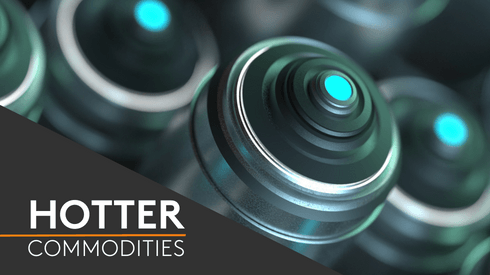“In order to get product with security of supply, the supply chain is interested in having a discussion about moving away from Chinese index pricing, moving to other pricing models in order to help development of rare earth projects,” Harrison said, regarding the attitude of end users procuring rare earths for neodymium iron boron (NdFeB) magnets in electric vehicle motors, offshore wind turbines, consumer electronics and defense applications.
The critical raw materials for NdFeB magnets are light rare earths neodymium and praseodymium, and heavy rare earths dysprosium and terbium.
China is the market leader in producing rare earth magnets, but the share of rare earths raw materials mined outside China is growing. A large share of heavy rare earth ore supply is imported from Myanmar to China, but supply is frequently disrupted due to border closures amid ongoing civil unrest in the country, Fastmarkets understands.
“From our perspective, we have seen interest from the automotive sector in supply from Makuutu,” Harrison said. “We have also seen key appetite emerging from rare earth refiners, alloys and magnet manufacturers.”
Makuutu a major focus
In recent months, Ionic has been securing access to the mining site in Makuutu, Uganda, by concluding agreements with local landowners. The miner obtained a majority share in the deposit of heavy rare earth-containing ionic clays from local company Rwenzori Rare Metals in 2019.
“Magnet rare earths are expected to have 85% of the rare earth revenue of the Makuutu project and remain a massive focus for the business,” Harrison said.
Ionic is seeking $121 million in funding to develop Makuutu, with key stakes coming from strategic investments, Harrison told Fastmarkets.
“We expect to make an investment decision [on funding for Makuutu] in the second half of 2024, targeting initial production for the supply chain in late 2025,” he said.
But he noted that the timeline is going to be driven by the forging of key relationships along the supply chain.
“There is appetite to potentially expedite the project,” Harrison said.
Makuutu’s planned annual capacity is 4,000 tonnes of mixed rare earth carbonate, an intermediate rare earth product that contains a mixture of elements depending on the deposit.
Ionic has been “in discussion” with potential investors, Harrison said. He said the company is expecting a mix of capital and equity investments, targeting a ratio of 60% debt and 40% equity.
Ionic sees “a lot of appetite coming from Europe, US, Japan and Korea,” according to Harrison.
As of November 29, Ionic had received access to “over 95%” of the territory covered by the mining license application. The company expects to secure the mining license this quarter, Harrison said.
Ionic plans to produce a first batch of mixed rare earth carbonate (MREC) in the first quarter of 2024 and send samples from Makuutu to potential offtake partners.
Final offtake would depend on the partnership established, Harrison said.
“Simply producing as much rare earths as we possibly can is not going to be in our best interests initially,” he said.
Minding the gap between mining and magnet recycling
IonicTech, formerly Seren Technologies, is a spun-off project of Queens University in Belfast, Northern Ireland. It was bought by Ionic in 2022.
IonicTech uses liquid-liquid extraction technology, which relies on liquid salts and ligands as solvents to extract rare earth elements from crushed magnets and offcuts from the magnet manufacturing process (swarf). Ligands are ions or molecules that bond with a central metal ion or atom.
Since June 2023, IonicTech has produced more than 10 tonnes of rare earth oxides – neodymium and dysprosium – at its demonstration plant in Belfast, according to its website. Its annual capacity can be ramped up to 30 tonnes of magnets.
IonicTech can use a range of feedstock, such as end-of-life magnets, oxidized and coated magnets, and swarf, Harrison said.
The company has been targeting existing stocks of end-of-life magnets, particularly those from wind turbines.
“The UK has been an early adopter of offshore wind, and discussions are ongoing about substantial inventories of magnets – some of them are decommissioned offshore wind turbines,” Harrison said.
“We are advancing discussions on access to wind turbines, both onshore and offshore, and to wind turbines coming from repowering,” Harrison said.
Repowering is a process where wind farm operators replace smaller wind turbines with larger ones to put limited land resources to better use.
Belfast offers a strategic and geographic advantage – it has a large harbor with good infrastructure, and several key market participants in the offshore wind industry operate there, Harrison said.
Ionic sees the emerging European policy framework – the Critical Raw Materials Act (CRMA) – as beneficial for magnet recycling in Northern Ireland through the Windsor Framework, according to Harrison.
The Windsor framework, announced in February 2023, is a set of measures aimed at maintaining border transparency between Ireland and Northern Ireland.
On November 13, the European Commission’s announced increased targets for recycling – to at least 25% of EU’s annual consumption of raw materials, which is up from 15% announced in March 2023.
Harrison added that this framework would provide access to markets across the UK and EU from Belfast.
Ionic sees the CRMA as beneficial for primary and secondary production of rare earths, for relationships with companies along the supply chain and for rolling out IonicTech’s know-how across its key target markets, Harrison said.
Visit our rare earths content hub to explore latest rare earths news and prices.






